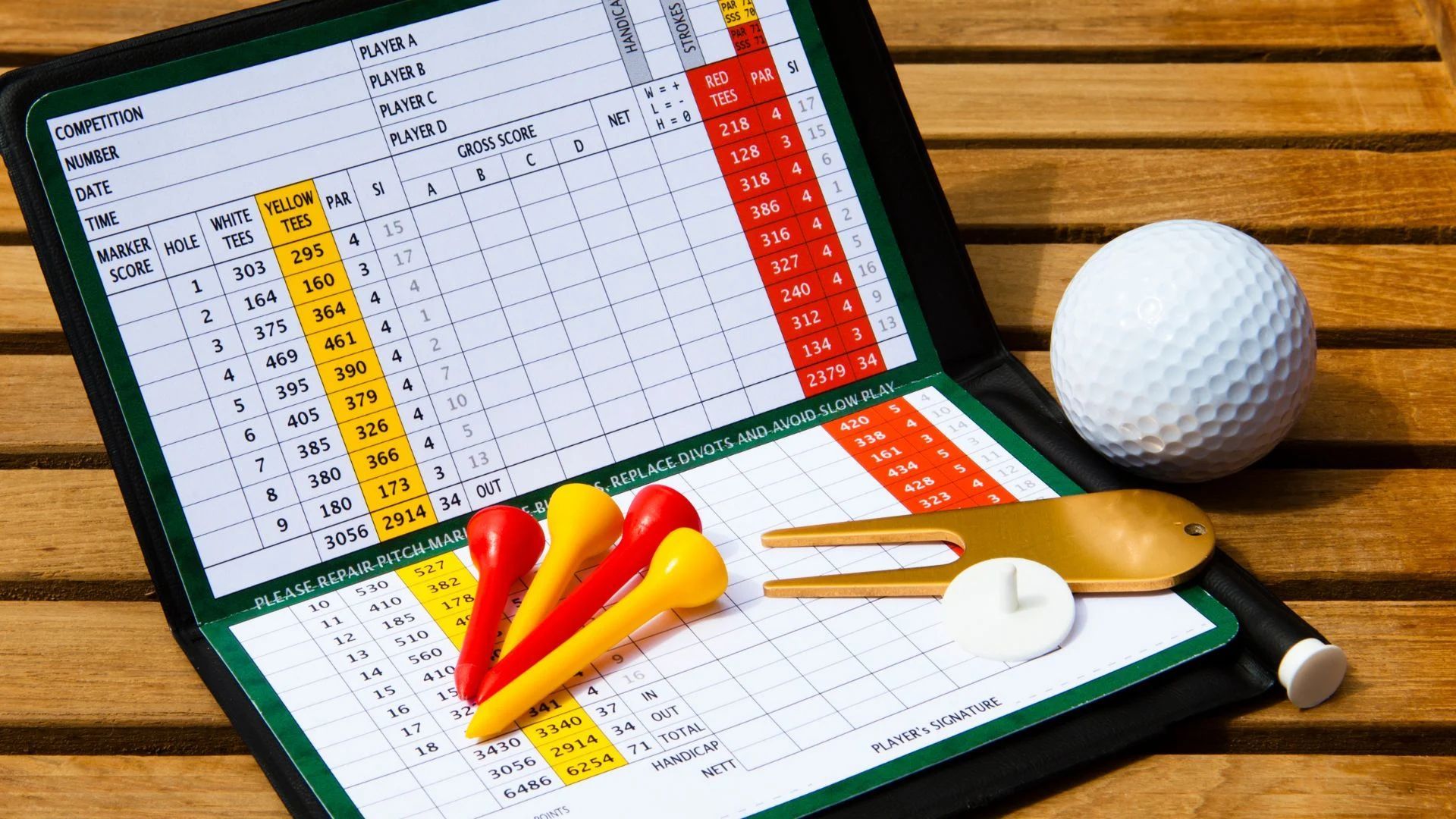How Golf Scoring Works: A Beginner’s Guide to the Numbers
Standing on the first tee box, scorecard in hand, many new golfers feel a surge of anxiety that has nothing to do with their swing. Understanding how golf scoring works isn’t just for the country club elite or those born with a silver putter in their hands. It’s an accessible system that, once decoded, transforms your entire experience on the course.
In our short guide, you’ll finally crack the code of golf scoring with:
• The real meaning behind those golf terms
• A foolproof method to navigate any scorecard
• The surprisingly simple math behind the handicap system
Whether you’ve played a few rounds of golf but still nod along when others discuss scores, or you’re preparing for your very first game, this guide strips away the confusion and lays bare the elegant simplicity of golf’s scoring system.
Let’s dive in and demystify golf scoring once and for all.

How Is Golf Scored? A Beginner’s Explanation
If you’re new to golf, understanding the scoring system is essential before stepping onto the course. Golf primarily uses a scoring format called “stroke play,” which is what you’ll encounter most frequently at courses and on television. The concept is straightforward:
- Each time you hit the ball, it counts as one stroke
- Every stroke is recorded as you progress through each hole
- Your goal is to complete each hole using as few strokes as possible
- The player with the lowest total number of strokes at the end of the round wins
Scorecards typically have a grid where you’ll record your strokes for each hole, with a space to tally your total at the end of the round. Most standard golf courses consist of 18 holes, though 9-hole courses are also common, especially for beginners.
What is the scoring system in golf?
Golf is scored by counting the total strokes it takes to get the ball in the hole on each hole. The goal is to use fewer strokes than the par score (what an expert golfer would take).
What Do You Need to Know about Par
Par serves as the standard against which all golfers measure their performance.
Golf holes are categorized into three main types based on their length:
- Par 3: The shortest holes on the course typically ranging from 100-250 yards. A skilled golfer is expected to reach the green in one shot and use two putts to finish.
- Par 4: Medium-length holes, usually between 250-470 yards. Golfers typically need two shots to reach the green, followed by two putts.
- Par 5: The longest holes, measuring 470-600+ yards. These holes generally require three shots to reach the green, plus two putts.
Most 18-hole courses have a total par between 70 and 72, with a mix of par 3s, 4s, and 5s. When you complete a hole using exactly the number of strokes designated as par, you’ve scored “par” on that hole.
The Golf Scoring System: The Language of the Links
Golf has developed a unique vocabulary to describe how well you perform on each hole relative to par:
- Bogey: Scoring one stroke over par on a hole (e.g., taking 5 strokes on a par 4)
- Par: Completing the hole in exactly the expected number of strokes
- Birdie: Scoring one stroke under par (e.g., completing a par 4 in 3 strokes)
- Eagle: Scoring two strokes under par (e.g., completing a par 5 in 3 strokes)
- Double Bogey: Scoring two strokes over par
- Triple Bogey: Scoring three strokes over par
For the ambitious beginners, there are even rarer scores:
- Albatross (or Double Eagle): Three under par (extremely rare)
- Hole-in-One (or Ace): Completing a hole in one stroke (typically on par 3s)
The Scorecard: Tracking Your Golf Score
A golf scorecard is your personal record-keeping tool during a round and contains crucial information about the course:
- Hole numbers (1-9 for front nine, 10-18 for back nine)
- Par for each hole
- Distance from each tee box to the hole
- Handicap rating for each hole (indicating difficulty)
- Space to record your score for each hole
What is a birdie, a bogey, and an eagle?
These are common golf scoring terms:
Birdie = 1 stroke under par
Bogey = 1 stroke over par
Eagle = 2 strokes under par
Digital Golf Scorekeepers for Modern Golfers:
Today’s beginners have excellent technological options for score tracking:
- Apps like GolfLogix, 18Birdies, and The Grint offer GPS features and digital scorekeeping
- Many smartwatches now include golf-specific functions
- Most golf apps can calculate handicaps automatically, track statistics, and even analyze your game
These digital tools can be especially helpful for beginners who want to focus on their game without the added pressure of manual scorekeeping, though learning to use a traditional scorecard builds fundamental golf knowledge that serves players at all levels.
How Do Golf Scores Work Across 9 or 18 Holes?
Golf’s scoring system remains consistent regardless of how many holes you play, but there are some important differences to understand when calculating your final score.
From Tee to Green: Counting Each Stroke
Every movement you make to advance the ball counts as a stroke on your scorecard:
- Tee shots: Your initial shot from the teeing ground counts as stroke #1
- Fairway shots: Any shots played from the fairway or rough as you progress toward the green
- Approach shots: Shots aimed at landing on the green
- Chip shots: Short shots played near the green
- Bunker shots: Strokes taken to escape sand traps
- Putts: All strokes taken on the putting green
Remember that penalty strokes also add to your score. For example, if your ball lands in a water hazard, you’ll typically add one penalty stroke to your score when taking relief.
Totaling Your Golf Score for the Round
Your total score accumulates differently depending on whether you’re playing 9 or 18 holes:
For a 9-hole round:
- Add up the strokes from each of the nine holes you played
- Compare your total to the 9-hole par total (typically between 34-36)
- Your final score is expressed relative to par (e.g., 40 strokes on a par-36 course would be “+4”)
For a full 18-hole round:
- Sum all strokes across all 18 holes
- Compare your total to the course par (usually between 70-72)
- Your final score is expressed relative to par (e.g., 90 strokes on a par-72 course would be “+18”)
Many beginners find it helpful to track their performance against par as they play. For example, if you finish the first hole with 6 strokes on a par-4, you’re “+2” on that hole. If you then score a 3 on a par-3 hole, you’re “even” on that hole, keeping you at “+2” overall. This running total helps you understand how you’re performing throughout your round.
What does 4 & 3 mean in golf?
In match play, “4 & 3” means a player is ahead by 4 holes with only 3 left to play, so they win! It’s a different scoring system in golf, focused on holes won, not total strokes.
The Golf Handicap System: Leveling the Playing Field
Golf’s unique handicap system is what makes the sport accessible to players of all skill levels. The handicap system allows everyone to compete fairly against one another, making golf one of the few sports where players of dramatically different abilities can enjoy meaningful competition.
What Is a Handicap in Golf?
A golf handicap is a numerical measure of a player’s potential playing ability, calculated based on their recent scoring history. The lower your handicap, the better your golf game. Here’s how it works:
- A scratch golfer (very skilled) has a handicap of 0
- Most recreational golfers have handicaps between 10 and 28
- Beginners might start with handicaps of 30 or higher
- The maximum handicap allowed is 54 for both men and women
The World Handicap System (WHS), implemented by the USGA and R&A in 2020, standardized handicapping globally. This system takes your 8 best scores from your last 20 rounds, factors in course difficulty, and calculates your handicap index—a portable number you can use at any golf course worldwide.
How a Handicap Impacts Your Golf Score
Your handicap directly affects your net score in a round through stroke allowances. Here’s a simple example:
Player A has a 5 handicap and shoots 80
- Gross score: 80
- Net score: 75 (80 – 5 = 75)
Player B has a 20 handicap and shoots 95
- Gross score: 95
- Net score: 75 (95 – 20 = 75)
In this scenario, despite Player A shooting 15 strokes better than Player B in actual score, their net scores are identical when handicaps are applied, creating a fair competition between players of different abilities.
Your Next Steps: From Scorecard to Fairway Mastery
Now that you’ve decoded the “secret language” of golf scoring, you’re ready to step onto the course with newfound confidence. Remember, every golfer, from PGA Tour professionals to weekend enthusiasts, started exactly where you are now. The scoring system that once seemed like an indecipherable puzzle should now feel like a tool that enhances your enjoyment of the game.
Ready to take your golf experience to the next level? Check out The Stacker. It will save you precious time and improve your game.



